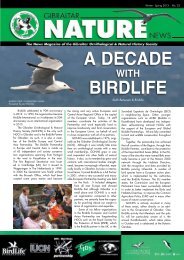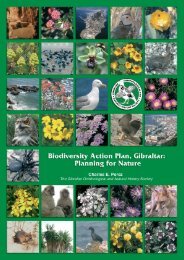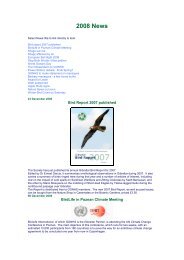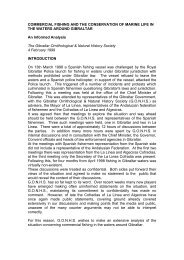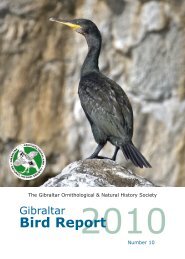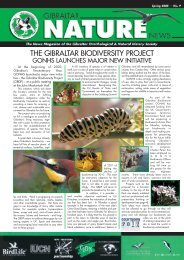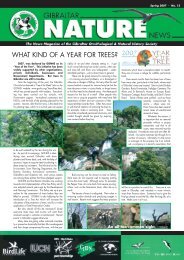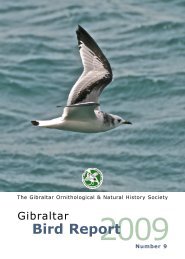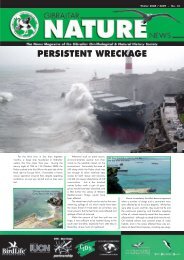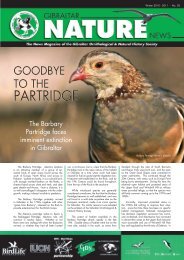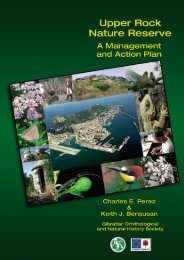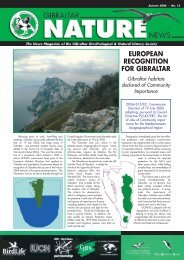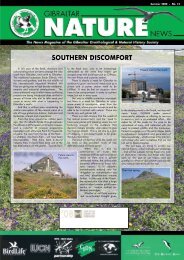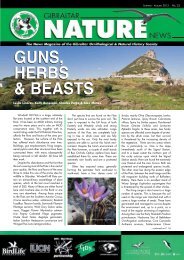2005 (No 5) - Gibraltar Ornithological & Natural History Society
2005 (No 5) - Gibraltar Ornithological & Natural History Society
2005 (No 5) - Gibraltar Ornithological & Natural History Society
You also want an ePaper? Increase the reach of your titles
YUMPU automatically turns print PDFs into web optimized ePapers that Google loves.
8 Bird Report <strong>2005</strong><br />
have therefore been adopted for this and future reports. The purists among you will<br />
have discovered that already.<br />
The situation with the vernacular names is a little different. For simplicity as<br />
well as for consistency, the Spanish names used are those adopted by the Spanish<br />
<strong>Ornithological</strong> <strong>Society</strong> (SEO/Birdlife) and used in the Lista de las Aves de España,<br />
Edición de <strong>2005</strong>. The English names, though, allow for an element of flexibility and,<br />
I have to admit, of personal preference.<br />
It is probably impossible to make the English names as rigorous as the scientific<br />
ones since many of them are of traditional origin and firmly embedded in common<br />
use. Any attempts to rename the Blackbird Turdus merula the Black Thrush or the<br />
Blackcap Sylvia atricapilla the Black-capped Warbler, for example, are surely doomed<br />
to failure. Yet there has been widespread acceptance of the trend to make certain very<br />
parochial names which have been in traditional use in Britain more specific. Hence, for<br />
example, Swallow, Wheatear and Swift (for Hirundo rustica, Oenanthe oenanthe and<br />
Apus apus respectively) are now Barn Swallow, <strong>No</strong>rthern Wheatear and Common<br />
Swift: you will probably know many more examples.<br />
Scope for confusion arises where several English names exist since, unlike<br />
the scientific names, there is no central authority responsible for these. The tendency<br />
is to qualify stand-alone names, such as Bee-eater (for Merops apiaster) and<br />
Sparrowhawk (for Accipiter nisus) with adjectives: in these two cases the proposed<br />
additions are geographical and we have European Bee-eater and Eurasian<br />
Sparrowhawk. This is fine but such handles are often unwieldy and, let’s face it,<br />
never used in common parlance. I have never heard any of the raptor watchers at<br />
Jews’ Gate call out ‘Eurasian Sparrowhawk’ (although they are bound to do so now<br />
once they read this !). The Bird Report uses the shorter names where no ambiguity<br />
exists, the authority for the identification always resting with the scientific name.<br />
Some English names have changed a good deal. During my ornithological<br />
lifetime I have ‘had’ to refer to Agrobates (now Cercotrichas) galactotes as the<br />
Rufous Warbler, Rufous Bush Chat (my favourite), Rufous-tailed Robin and, now,<br />
Rufous-tailed Scrub Robin. The guiding principle in this report is to use those<br />
names which are in common and widespread usage. In most cases they are those<br />
adopted by the British Ornithologists’ Union but there have been occasional departures:<br />
we stopped calling our resident gulls Herring Gulls many years before the<br />
BOU adopted the name Yellow-legged Gull for Larus michahellis.<br />
Names will always change, whether we like it or not, but we are always free<br />
to call anything by any name we like: except when trying to communicate with others<br />
in print. Most importantly, the names we give birds are labels of convenience to<br />
ourselves and they do not alter the actual relationships between existing groups<br />
and species. Name them as we will, the birds remain the same.<br />
* The <strong>Gibraltar</strong> List may be consulted on the GONHS website: www.gonhs.org



